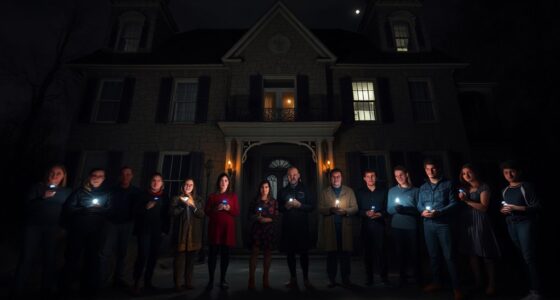To investigate urban legends, start by questioning their origins and cultural context, recognizing that stories mix fact and fiction. Look for evidence that supports or debunks claims, and consider how stories evolve over time within communities. Understanding their functions—whether for morality, explanation, or entertainment—helps you see through exaggerations. If you look deeper, you’ll find many legends reflect societal fears and values. Keep exploring to uncover more about the truth behind these intriguing stories.
Key Takeaways
- Examine the origins and cultural context to determine whether an urban legend is based on factual events or fabricated stories.
- Analyze how legends evolve over time and across communities to distinguish between original facts and exaggerated folklore.
- Identify the functions of legends, such as morality reinforcement or societal fears, to understand their purpose beyond entertainment.
- Use critical thinking and fact-checking to assess the plausibility of the story and verify details with credible sources.
- Recognize that urban legends often reflect societal values and fears, providing insight into cultural beliefs rather than absolute truths.

Have you ever wondered whether urban legends are based on truth or just clever stories? It’s a question many people ask as they hear tales passed around, often with a mix of fact and fiction. To truly understand these stories, you need to explore their myth vs. reality aspects and uncover their cultural origins. Urban legends often seem like modern folklore, but they’re rooted in deeper cultural contexts that shape their development. Recognizing these origins helps you see why certain stories resonate so strongly and spread so quickly. They reflect societal fears, morals, or historical events, even if exaggerated or distorted over time. For example, a story about a haunted house might have begun as a cautionary tale about trespassing, but today it’s a spooky myth that captures imaginations. When investigating, you need to look at the cultural origins behind these legends, because that’s where their power lies. Many legends originate from specific communities or regions, often tied to local history, geography, or social issues. You might find that a story about a monster in a lake started as a way to explain strange sightings or protect children from wandering near dangerous waters. Understanding these origins helps you differentiate between myth and reality, as some legends are based on real events, even if they’ve been exaggerated. Others are outright fabrications, designed to entertain, warn, or manipulate. For instance, urban tales about poisoned candy at Halloween sometimes stem from real fears about child safety, but they’ve been blown out of proportion into urban myth. Additionally, considering the safety features of products like electric heated mattress pads can help evaluate how such stories about safety risks are created or amplified. By examining how these stories evolve, you see how they serve cultural functions—whether to reinforce moral lessons, explain mysterious phenomena, or simply entertain. You should also consider that legends adapt as they pass through different communities, taking on new forms and meanings. This fluidity makes it challenging to separate fact from fiction, but it also makes investigating them fascinating. When you approach urban legends with a critical eye, you realize that their power isn’t necessarily in their truth but in what they reveal about human nature and societal values. So, the next time you hear a chilling tale, ask yourself: what’s the myth vs. reality? Where did this story come from? What cultural origins shaped it? Doing so transforms your understanding of urban legends from mere stories to windows into the collective psyche of the cultures that created them.
Frequently Asked Questions
How Do Urban Legends Typically Originate?
Urban legends usually originate from stories that have historical origins or cultural roots, then evolve into folklore over time. You might hear a story passed down through communities, often exaggerated or altered with each retelling. These legends thrive because they tap into shared fears, morals, or humor. As they spread, they transform, blending fact with fiction, which keeps them relevant and intriguing, even if their true origins are uncertain.
What Psychological Factors Influence Belief in Urban Legends?
You’re influenced by cognitive biases like confirmation bias, which makes you believe urban legends that match your existing beliefs. Social conformity also plays a role, as you’re more likely to accept and share legends to fit in with others. These psychological factors heighten your susceptibility, making urban legends seem more credible and convincing, especially when they’re reinforced by group opinions and shared experiences.
Are There Common Themes Across Different Cultures’ Legends?
Yes, across cultures, you’ll notice common themes in urban legends rooted in cultural motifs and storytelling patterns. These legends often reflect universal fears, moral lessons, or societal values, making them relatable regardless of background. As you explore different legends, you’ll see recurring motifs like warnings about strangers, supernatural consequences, or moral lessons, all shaped by distinct cultural storytelling patterns that help communities transmit their beliefs and fears.
How Can Technology Help Debunk Urban Myths?
Cutting through the noise, technology is your best ally in debunking urban myths. Digital forensics allows you to analyze evidence and uncover falsehoods, while crowdsourcing verification harnesses collective knowledge to validate claims quickly. By leveraging these tools, you can separate fact from fiction efficiently, exposing urban legends as myths before they spread further. Embracing tech helps you stay one step ahead in the battle against misinformation.
What Role Do Social Media Platforms Play in Spreading Folklore?
Social media platforms play a major role in spreading folklore by amplifying viral misinformation through their platform algorithms. When you share or engage with a story, the algorithms prioritize it, making it more visible and accessible to others. This rapid dissemination fuels the spread of urban legends, often blurring the lines between fact and fiction. Being cautious and verifying information before sharing helps curb the spread of false folklore on these platforms.
Conclusion
As you explore urban legends, remember that many stories blend fact and fiction. For example, consider the myth of the alligators in New York sewers—while some reports suggest sightings, most experts see it as folklore. By questioning sources and seeking evidence, you can uncover the truth behind these tales. Ultimately, understanding the origins of legends helps you appreciate their cultural significance without accepting them blindly. Stay curious and critical as you investigate.








